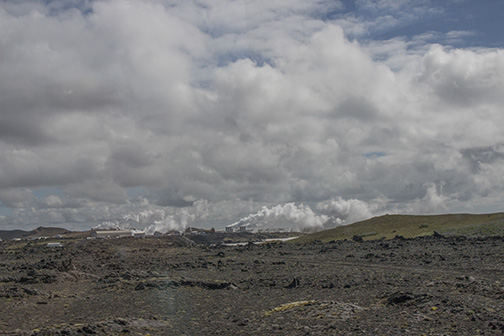Leaving the port by bus, the thing that impressed me the most were the many fields of purple Lupine.
I learned later that having been introduced from Alaska in 1945, they have become an item of controversy for the country. Originally planted as a source of nitrogen for the poor desert like soil and an anchor for vegetation, they became a invasive, foreign species that was overwhelming the native species, especially the woolly moss, or "graymoss" as it is know in Iceland, that covers the lava flows. There is now a serious effort to eradicate it from many areas around the "ring road, that runs around the perimeter of Iceland.
We spotted our first stop in the distance by the steam rising in front of a distant mountain, the world famous "Blue Lagoon". A mixture of sea and fresh water heated by geothermal sources on a lava field, it has become world famous.
We stopped on the way in to feel the temperature of the run-off water, and to observe the very
delicate graymoss that covers the lava flow.
Though it looked very inviting, we were not prepared, nor was there the time to enjoy the lagoon.
In 2012, the Blue Lagoon was designated by National Geographic one of the 25 wonders of the world.
However, a close-up view showed the mineral deposits, mostly silica and sulfur that are supposed to have such a healing effect on skin disorders.
There were a lot of happy people bellied-up to the pool bar, and several with the mud from the lagoon plastering their faces. The water temperature averages 99-102 F, and completely changes every 2 days.
As you can see towels and robes are available for use for the several hundred thousand people who use this place every year. Quite an undertaking. The geothermal power plant that sits behind the lagoon supplies electricity and after going through the turbines, the steam and hot water passes through a heat exchanger to provide heat for a municipal water heating system. Then the water is fed into the lagoon for recreational and medicinal users to bathe in.
These mud pots were bubbling away, but without a tripod I couldn't get the effect.
This old Reykjavik Peninsula Lighthouse atop a hill of lava is no longer in use.
But under a blue sky the shore line was beautiful.
The black beach in this cove attests to the power of the ocean to wear away the volcanic rock.
Our next stop was at Seltun, a high temperature Geothermal area with mud pots and
This stream runs between several different areas. I am sure it is HOT water.
At a depth of 1000 meters the temperature reach 200 degrees F. Around the vents are deposits of sulfur that at one time was used for gunpowder.
It was still a beautiful, active, ever changing scene.
On the way to the coast we passed the Hellisheiði power plant, the largest
single site geothermal power plant in the world.But under a blue sky the shore line was beautiful.
The black beach in this cove attests to the power of the ocean to wear away the volcanic rock.
The cliffs where I stand to take this picture is a bird paradise where thousands of seabirds nest each summer. The most common are guillemot, razorbill, Brünnich's guillemot, kittiwake, puffin, black guillemot, fulmar and cormorant.
The 77m high Eldey island serves as a home to around 16.000 Gannets. The island is made of hylaciastite and is part of rocks and skerries that extend 85 km out to sea.
Wild flowers grow even in these volcanic stones.
The Viking heritage is still strong in Iceland, as was evidenced by our last stop.
Wild flowers grow even in these volcanic stones.
The Viking heritage is still strong in Iceland, as was evidenced by our last stop.

























No comments:
Post a Comment